
A National Who Wants to Be a Mathematician at the 2010 Joint Mathematics Meetings
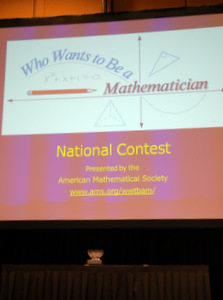
"I can't thank you enough for all that you have done in putting together this contest--what a great way to promote mathematics!"
"My students really enjoyed the competition. Overall, it was a great opportunity to expose my students to math outside the classroom and inspire many of my students to work hard. Thank you for all your hard work in organizing Who wants to Be a Mathematician. And, WOW, Evan is amazing."
"The contest was... a blast, to say the least! Thank you for organizing it! I wish you good luck in extending it and making a regular event at the AMS/MAA meetings every year. I hope more research mathematicians are encouraged to come and watch in the future, as this will bridge more of the bright high school students with prominent mathematicians."
"Thank you so much for the honor of participating in Who Wants to Be a Mathematician. The game was thrilling, the questions were exciting, and the memories are amazing. From the math talks to the clam chowder on Fisherman’s Wharf to the actual competition, the entire weekend was so wonderful, and you and the American Mathematical Society have given me an experience I will never forget."
|
|
Evan O’Dorney of Danville, California won $10,000 in the national Who Wants to Be a Mathematician Thursday, January 14 at the Joint Mathematics Meetings in San Francisco. Evan is a junior who is home-schooled and who participates in the Berkeley Math Circle. He won the National Spelling Bee in 2007 and won silver medals at the International Mathematical Olympiad in 2008 and 2009. He’s a worthy recipient in that his career goal is to become a math professor. The money that he won will be split 50-50 with the Berkeley Math Circle. Below is a description of the first national tournament. |
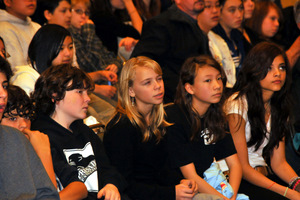 |
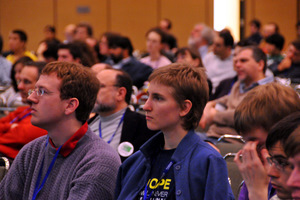 |
 |
 |
In the contest, 10 students from across the country played two semifinals, of five students each. The two winners of the semifinals squared off in the finals for the grand prize. Both semifinals were very exciting: In each, two contestants tied for first, so a tie-breaking question was used to determine the finalists. Below are the ten contestants (read more about them here).
 |
|
|
Front (left to right):
|
Back (left to right):
|
|
In the first semifinal, with students who live east of the Mississippi River, Daniel and Ben answered every question correctly. Then Ben was first to answer the tie-breaking question correctly, which put him in the finals. Ben delighted the audience when he told them how he and his sister formed a musical duo, Siblings Unplugged to entertain nursing home residents in his area. Daniel said that he plans to donate some of his winnings to his high school to help in the creation of a math and science library. |

Photo by E. David Luria |
|
In the second semifinal, Evan and Charles tied for first, while Rohit, Kathy, and Kevin tied for third. Kevin was in the lead late in the game, but was passed on the last question by Evan and Charles. Charles, who is a pretty humorous guy and two-time participant in the Mathematical Olympiad Summer Program, got to use the official Who Wants to Be a Mathematician pointer to explain his answer to a geometry problem. In the tie-breaker, a problem about numbers, Evan answered first correctly and earned a spot in the finals with Ben. |
Photo by E. David Luria |
| (The next three photos are by E. David Luria.) | |
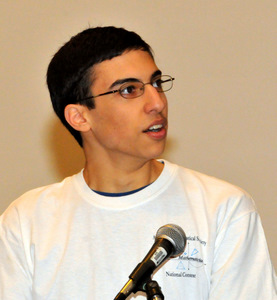 |
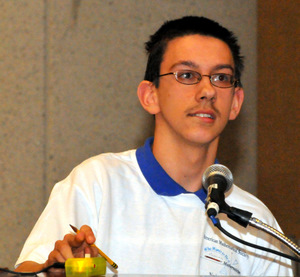 |
In the finals, only the first person to answer the question correctly earned points (similar to the format of the tie-breakers). Evan amazed the audience with his quickness, and his correctness, and won the finals over Ben. The only time Evan was judged wrong, it turned out that he was right (because of a rearrangement of the choices the night before and not remembering to register the rearrangement on the judges’ printouts). Evan wisely stood by his mathematical guns on that question and explained his answer beautifully and received his deserved points. Before the last question, he had already clinched the championship, but he answered that one correctly, too.
Evan and Ben each received a Klein bottle (one is pictured below) from Cliff Stoll in addition to their other prizes.
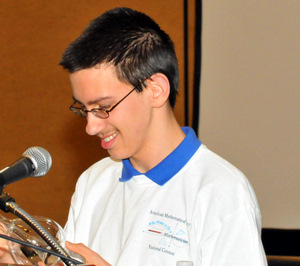 |
After the contest, the contestants received awards at a ceremony presided over by Ken Ono, whose National Science Foundation Director's Distinguished Teaching Scholar Award helped pay for the contest. The contestants were welcomed and congratulated by AMS Executive Director Don McClure and AMS President George Andrews. They received their awards from Joseph Harris (Harvard University), Olga Holtz (University of California, Berkeley), Richard Stanley (MIT), and Maria Monks (2009 Alice T. Schafer Prize winner, MIT).
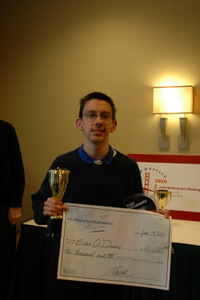 |
|
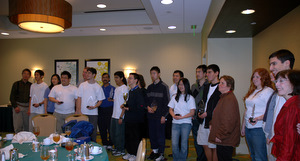 |
|
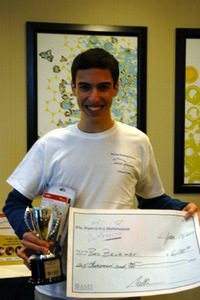
Here are the prizes and cash won by the contestants in Who Wants to Be a Mathematician. Each cash prize is matched by an equal amount that will be given to the math department of the contestant’s school. In Evan’s case, since he is home-schooled, the money will go to the Berkeley Math Circle.
- TI-Nspire graphing calculator from Texas Instruments and $5000 from the AMS: Evan O'Dorney
- TI-Nspire graphing calculator from Texas Instruments and $3000 from the AMS: Ben Zauzmer
- Maple 13 from Maplesoft and $1000 from the AMS: Daniel Li and Charles Xu
- Calculus by Anton, Bivens and Davis from John Wiley and Sons and $1000 from the AMS: Ofir Nachum
- Calculus by Anton, Bivens and Davis from John Wiley and Sons and $667 from the AMS: Rohit Agrawal
- What's Happening in the Mathematical Sciences and $667 from the AMS: Kathy Lin
- Five-Minute Mathematics and $667 from the AMS: Kevin Yin
- What's Happening in the Mathematical Sciences and $500 from the AMS: Brian Freidin
- Five-Minute Mathematics and $500 from the AMS: Rebecca Easterwood
The AMS thanks sponsors Texas Instruments, Maplesoft, John Wiley and Sons, and the National Science Foundation for their continued generous support of Who Wants to Be a Mathematician.
See the San Francisco Channel 7 evening news segment on the contest.
Uncredited (until now) photographs by AMS Public Awareness Officer Annette Emerson. Text by Mike Breen.
Find out more about Who Wants to Be a Mathematician .
See other highlights of the 2010 Joint Mathematics Meetings.



